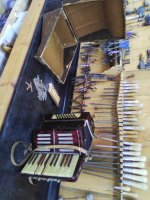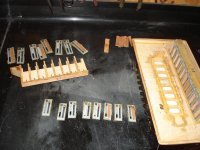Bullrat
Member
I just received a free Horch accordion that I would like to bring back to playable condition before I learn how to play it. To do that I need a reference document, manual or parts diagram that shows it's construction. Then I'll need a parts source for anything I find irreparable in my shop. I'll include a picture of what I now have.
I've fixed, repaired and created other items, with the help of the Internet, and love the learning process of applicable reconstruction, repair or creation. Old treadle Singer Sewing machines, banjos, Resonator guitars, bagpipes, 1880 camp stove, 62 Willys Station Wagon come immediately to mind. I'm looking forward to a musical instrument I have always wanted to learn. 1950-70 childhood in Western Pa. was full of East European cultures that learned to walk and Polka about the same time. The accordion was much in evidence.
Thanks in advance for any help I may receive.
Chet
Voluntown, Ct
I've fixed, repaired and created other items, with the help of the Internet, and love the learning process of applicable reconstruction, repair or creation. Old treadle Singer Sewing machines, banjos, Resonator guitars, bagpipes, 1880 camp stove, 62 Willys Station Wagon come immediately to mind. I'm looking forward to a musical instrument I have always wanted to learn. 1950-70 childhood in Western Pa. was full of East European cultures that learned to walk and Polka about the same time. The accordion was much in evidence.
Thanks in advance for any help I may receive.
Chet
Voluntown, Ct




